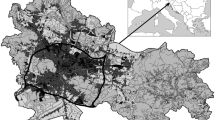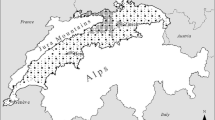Abstract
Urban areas have developed under anthropogenic impact and hence feature strongly altered environmental conditions that influence today’s plant species distribution. Generally, urban areas are rich in plant species, but on smaller scales richness can vary considerably. Our study aim is to identify areas of high species richness and to assess richness distribution patterns in the city of Hamburg by analyzing a floristic mapping dataset on the scale of 1 km2. Differences in plant species richness were analyzed between three urbanization zones. With multiple regression analyses, we tested effects of urban structure, habitat, and environmental conditions on the distribution of species richness measures. Total species richness per 1 km2 was 274 ± 60 on average and differed only slightly between the urbanization zones. It increased with habitat diversity and decreased with Ellenberg indicator values (EIV) for nutrients (multiple R2 = 0.31). Proportion of non-native species increased with mean annual temperature and decreased with EIVs for moisture (multiple R2 = 0.72), while proportion of endangered species increased with EIVs for moisture and decreased with EIVs for nutrients (multiple R2 = 0.66). Proportion of thermophilic species (multiple R2 = 0.58) could be explained by mean annual temperature. The emerging patterns probably differ from those in other cities due to the central port harboring a particular flora. Besides the expected high proportions of non-native species, high proportions of endangered species were also found in this area. Our results contribute to identifying drivers of biodiversity in cities and can thus be used to develop measures for the conservation of urban biodiversity.




Similar content being viewed by others
References
Bechtel B, Schmidt KJ (2011) Floristic mapping data as a proxy for the mean urban heat island. Clim Res 49:45–58
Brunzel S, Fischer SF, Schneider J, Jetzkowitz J, Brandl R (2009) Neo- and archaeophytes respond more strongly than natives to socio-economic mobility and disturbance patterns along an urban–rural gradient. J Biogeogr 36:835–844
Celesti-Grapow L, Blasi C (1998) A comparison of the urban flora of different phytoclimatic regions in Italy. Glob Ecol Biogeogr 7:367–378
Celesti-Grapow L, Pyšek P, Jarosik V, Blasi C (2006) Determinants of native and alien species richness in the urban flora of Rome. Divers Distrib 12:490–501
Chytrý M, Hejcman M, Hennekens SM, Schellberg J (2009) Changes in vegetation types and Ellenberg indicator values after 65 years of fertilizer application in the Rengen Grassland Experiment, Germany. Appl Veg Sci 12:167–176
Cornwell WK, Grubb PJ (2003) Regional and local patterns in plant species richness with respect to resource availability. Oikos 100(3):417–428
Deutschewitz K, Lausch A, Kuehn I, Klotz S (2003) Native and alien plant species richness in relation to spatial heterogeneity on a regional scale in Germany. Glob Ecol Biogeogr 12:299–311
Diekmann M (2003) Species indicator values as an important tool in applied plant ecology—a review. Basic Appl Ecol 4:493–506
Dolan RW, Moore ME, Stephens JD (2011) Documenting effects of urbanization on flora using herbarium records. J Ecol 99:1055–1062
Dunn C, Heneghan L (2011) Composition and diversity of urban vegetation. In: Niemelä J, Breuste J, Elmquist T, Guntenspergen G, James P, McIntyre NE (eds) Urban Ecology. Oxford Univ Press, Oxford, pp 103–114
Ellenberg H, Düll R, Wirth W, Werner W, Paulißen D (1992) Zeigerwerte von Pflanzen in Mitteleuropa, 2nd edn. Erich Goltze KG, Göttingen
Faeth SH, Bang C, Saari S (2011) Urban biodiversity: patterns and mechanisms. In: Ostfeld RS, Schlesinger WH (eds) The year in ecology and conservation biology. Blackwell Science Publ, Oxford, pp 69–81
Federal Statistical Office of Germany (2011) http://www.statistik-portal.de/statistik-portal/de_jb09_jahrtabf1.asp; Accessed 05 October 2012
Fuller RA, Irvine KN, Devine-Wright P, Warren PH, Gaston KJ (2007) Psychological benefits of greenspace increase with biodiversity. Biol Lett 3:390–394
Gilbert OL (1989) The ecology of urban habitats. Chapman and Hall Ltd., London
Godefroid S (2001) Temporal analysis of the Brussels flora as indicator for changing environmental quality. Landsc Urban Plan 52:203–224
Godefroid S, Koedam N (2007) Urban plant species patterns are highly driven by density and function of built-up areas. Landsc Ecol 22:1227–1239
Goedde M, Wittig R (1983) A preliminary attempt at a thermal division of the town of Munster (North Rhine-Westphalia, West-Germany) on a floral and vegetational basis. Urban Ecol 7:255–262
Gregor T, Boensel D, Starke-Ottich I, Zizka G (2012) Drivers of floristic change in large cities—a case study of Frankfurt/Main (Germany). Landsc Urban Plan 104:230–237
Groemping U (2006) Relative importance for linear regression in R: the package relaimpo. J Stat Softw 17:1–27
Haeupler H (2000) Die ungleiche Verteilung der Artenvielfalt innerhalb Deutschlands—Eine Antwort. Flor Rundbr 34(1):17–24
Haeupler H (2002) Die Biotope Deutschlands. Schr reihe Veg kd 247–272
Hope D, Gries C, Zhu WX, Fagan WF, Redman CL, Grimm NB, Nelson AL, Martin C, Kinzig A (2003) Socioeconomics drive urban plant diversity. Proc Natl Acad Sci USA 100:8788–8792
Jehlîk V (1981) Beitrag zur synanthropen (besonders Adventiv-) Flora des Hamburger Hafens. Tuexenia 1:81–97
Jehlîk V (1989) Zweiter Beitrag zur synanthropen (besonders Adventiv-) Flora des Hamburger Hafens. Tuexenia 9:253–266
Jim CY, Chen WY (2009) Urbanization effect on floristic and landscape patterns of green spaces. Landsc Res 34:581–598
Kent M, Stevens RA, Zhang L (1999) Urban plant ecology patterns and processes: a case study of the flora of the City of Plymouth, Devon, UK. J Biogeogr 26:1281–1298
Klaus VH, Kleinebecker T, Boch S, Mueller J, Socher SA, Prati D, Fischer M, Hoelzel N (2012) NIRS meets Ellenberg’s indicator values: prediction of moisture and nitrogen values of agricultural grassland vegetation by means of near-infrared spectral characteristics. Ecol Indic 14:82–86
Klotz S, Kuehn I, Durka W (eds) (2002) BIOLFLOR—Eine Datenbank mit biologisch-ökologischen Merkmalen zur Flora von Deutschland. Schriftenreihe für Vegetationskunde, Bonn
Knapp S, Kuehn I, Bakker JP, Kleyer M, Klotz S, Ozinga WA, Poschlod P, Thompson K, Thuiller W, Roemermann C (2009) How species traits and affinity to urban land use control large-scale species frequency. Divers Distrib 15:533–546
Kowarik I (2011) Novel urban ecosystems, biodiversity, and conservation. Environ Pollut 159:1974–1983
Kowarik I, Saeumel I (2007) Biological flora of Central Europe: Ailanthus altissima (Mill.) Swingle. Perspect Plant Ecol Evol Syst 8:207–237
Krauss J, Klein A, Steffan-Dewenter I, Tscharntke T (2004) Effects of habitat area, isolation, and landscape diversity on plant species richness of calcareous grasslands. Biodivers Conserv 13:1427–1439
Kuehn I, Brandl R, Klotz S (2004) The flora of German cities is naturally species rich. Evol Ecol Res 6:749–764
Lawson DM, Lamar CK, Schwartz MW (2008) Quantifying plant population persistence in human-dominated landscapes. Conserv Biol 22:922–928
Lindberg F, Grimmond CS (2011) Nature of vegetation and building morphology characteristics across a city: influence on shadow patterns and mean radiant temperatures in London. Urban Ecosyst 14:617–634
Lososová Z, Horsák M, Chytrý M, Čejka T, Danihelka J, Fajmon K, Hájek O, Juřičková L, Kintrová K, Láníková D, Otýpková Z, Řehořek V, Tichý L (2011) Diversity of Central European urban biota: effects of human-made habitat types on plants and land snails. J Biogeogr 38:1152–1163
Lovett GM, Traynor MM, Pouyat RV, Carreiro MM, Zhu WX, Baxter JW (2000) Atmospheric deposition to oak forests along an urban–rural gradient. Environ Sci Technol 34:4294–4300
McKinney M (2002) Urbanization, biodiversity, and conservation. BioScience 52:883–890
McKinney M (2008) Effects of urbanization on species richness: a review of plants and animals. Urban Ecosyst 11:161–1769
Meyer H (1955) Zur Adventivflora von Harburg, Wilhelmsburg und Umgebung. Harburger Jahrbuch 96–128
Miehlich G, Brandt I (2010) Natürliche Bodenformengesellschaften Hamburgs—Karte mit Erläuterungstext. Gutachten im Auftrag der Behörde für Stadtentwicklung und Umwelt, Hamburg
Muratet A, Machon N, Jiguet F, Moret J, Porcher E (2007) The role of urban structures in the distribution of wasteland flora in the greater paris area, France. Ecosystems 10:661–671
Niemelä J (1999) Ecology and urban planning. Biodivers Conserv 8:119–131
Nowak DJ, Crane DE (2002) Carbon storage and sequestration by urban trees in the USA. Environ Pollut 116:381–389
Oke TR (1982) The energetic basis of the urban heat island. Q J R Meteorol Soc 108:1–24
Pautasso M (2007) Scale dependence of the correlation between human population presence and vertebrate and plant species richness. Ecol Lett 10:16–24
Pellissier V, Rozé F, Aguejdad R, Quénol H, Clergeau P (2008) Relationships between soil seed bank, vegetation and soil fertility along an urbanisation gradient. Appl Veg Sci 11:325–334
Poppendieck HH, Brandt I, von Prondzinski J, Kreft KA (2002) Artenkataster Hamburg im Spannungsfeld von staatlicher Aufgabe und ehrenamtlichem Engagement. Schr reihe Veg kd 69–77
Poppendieck H, Bertram H, Brandt I, Engelschall E, von Prondzinski J (eds) (2010) Der Hamburger Pflanzenatlas. von a bis z. Dölling und Galitz Verlag, München
Pouyat RV, McDonnell MJ (1991) Heavy-metal accumulations in forest soils along an urban–rural gradient in Southeastern New York, USA. Water Air Soil Pollut 57–8:797–807
Pyšek P (1993) Factors affecting the diversity of flora and vegetation in Central-European settlements. Vegetatio 106:89–100
Pyšek P (1998) Alien and native species in Central European urban floras: a quantitative comparison. J Biogeogr 25:155–163
R Development Core Team (2010) R: a language and environment for statistical computing. R Foundation for Statistical Computing, Vienna
Robinson SL, Lundholm JT (2012) Ecosystem services provided by urban spontaneous vegetation. Urban Ecosyst 15:545–557
Roy DB, Hill MO, Rothery P (1999) Effects of urban land cover on the local species pool in Britain. Ecography 22:507–515
Schaffers AP, Sykora KV (2000) Reliability of Ellenberg indicator values for moisture, nitrogen and soil reaction: a comparison with field measurements. J Veg Sci 11(2):225–244
Schluenzen KH, Hoffmann P, Rosenhagen G, Riecke W (2010) Long-term changes and regional differences in temperature and precipitation in the metropolitan area of Hamburg. Int J Climatol 30:1121–1136
Susca T, Gaffin SR, Dell’Osso GR (2011) Positive effects of vegetation: urban heat island and green roofs. Environ Pollut 159:2119–2126
Ter Braak CJ, Barendregt LG (1986) Weighted averaging of species indicator values—its efficiency in environmental calibration. Math Biosci 78:57–72
van der Veken S, Verheyen K, Hermy M (2004) Plant species loss in an urban area (Turnhout, Belgium) from 1880 to 1999 and its environmental determinants. Flora 199:516–523
von der Lippe M, Kowarik I (2008) Do cities export biodiversity? Traffic as dispersal vector across urban–rural gradients. Divers Distrib 14:18–25
Walker JS, Grimm NB, Briggs JM, Gries C, Dugan L (2009) Effects of urbanization on plant species diversity in central Arizona. Front Ecol Environ 7:465–470
Wang HF, MacGregor-Fors I, Lopez-Pujol J (2012) Warm-temperate, immense, and sprawling: plant diversity drivers in urban Beijing, China. Plant Ecol 213:967–992
Wania A, Kuehn I, Klotz S (2006) Plant richness patterns in agricultural and urban landscapes in Central Germany—spatial gradients of species richness. Landsc Urban Plan 75:97–110
Wittig R (2004) The origin and development of the urban flora of Central Europe. Urban Ecosyst 7:323–339
Zerbe S, Maurer U, Schmitz S, Sukopp H (2003) Biodiversity in Berlin and its potential for nature conservation. Landsc Urban Plan 62:139–148
Acknowledgments
We are grateful to the Botanischer Verein zu Hamburg e.V. and the Regionalstelle für Pflanzenartenschutz for providing the extensive data set on plant species distribution and all volunteers who contributed to mapping the flora of Hamburg. We wish to thank the German Meteorological Service (DWD), the Federal State Agency for urban development and environment (BSU) Hamburg and G.Miehlich & I.Brandt for the provision of data on predictors and Melissa Kostelecky for linguistic proofreading of the manuscript. We also thank two anonymous reviewers for helpful comments that improved our manuscript.
Funding
The work was funded by the Federal Ministry for Education and Research within the research project KLIMZUG-NORD (grant number 01LR0805D).
Author information
Authors and Affiliations
Corresponding author
Rights and permissions
About this article
Cite this article
Schmidt, K.J., Poppendieck, HH. & Jensen, K. Effects of urban structure on plant species richness in a large European city. Urban Ecosyst 17, 427–444 (2014). https://doi.org/10.1007/s11252-013-0319-y
Published:
Issue Date:
DOI: https://doi.org/10.1007/s11252-013-0319-y




